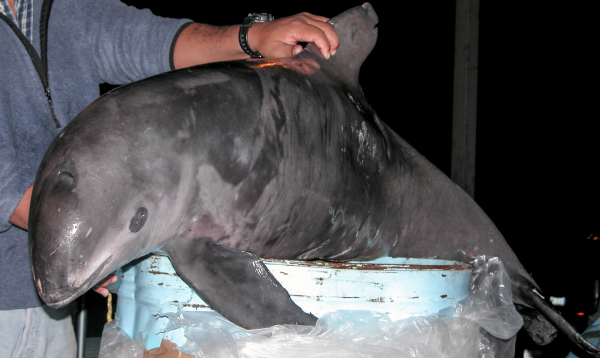‘Without action the vaquita will be gone – the second entirely preventable
cetacean extinction we will have witnessed in the last ten years.’
The report of the IWC Scientific Committee is published today. Its many findings and conclusions include this stark warning on the plight of the vaquita, a small porpoise found only in the Gulf of California, Mexico.
This year the Committee received additional information about a dramatic escalation in the illegal fishing which has reduced the only vaquita population in the world by 92% in less than twenty years. A Chinese black market trade in the swim bladder of the totoaba fish drives the gillnet fisheries which catch totoaba and also trap vaquita. The fishing is illegal. Despite enforcement action by the Mexican Government, high demand has escalated fishing activity and it’s estimated that there are now less than 60 vaquita left. The Scientific Committee repeated calls for a permanent gillnet ban and increased enforcement action, not just in Mexico but in all countries involved in the smuggling and trade of totoaba.
The mass die-off of 305 sei whales in Chile was also discussed by the Committee who described the event as unprecedented. Establishing the cause of any cetacean mass mortality is challenging. This one occurred in a remote region and the whales were already in a state of decomposition when examined.
Some necropsies detected harmful biotoxins in the whales’ stomachs. The same toxins were detected in mussels collected in the region, but not in water samples collected later, and no other species appear to have been affected. The Committee discussed the possibility that there may have been a number of contributing factors and recommended follow up work including ongoing monitoring and annual surveys of the population, and allocated funds so that aerial surveys can be conducted.
Another agenda item generating significant discussion was the Scientific Committee’s review of special permit whaling. Also known as ‘scientific whaling,’ special permit whaling is not regulated by the IWC but by national governments, although governments are required to share proposals and findings from special permit programmes with the Scientific Committee.
Two separate programmes were discussed at the meeting. The first, NEWREP-A is a Government of Japan special permit research programme in the Southern Ocean. The proposal for this new programme was first considered by an Expert Panel and then by the Scientific Committee in 2015. The discussions at this year’s Scientific Committee meeting aimed to assess progress by the proponents (Government of Japan) towards a number of recommendations made by the Expert Panel. Discussions were extremely technical and focused on whether objectives can be met using non-lethal techniques.
The second programme discussed was JARPN-II, a North Pacific programme which began in 2000 and concluded in 2016. Another Expert Panel had reviewed the final report of this programme. The findings of this Expert Panel, and the response of the proponents, were both reviewed by the Scientific Committee. Again the discussions were highly technical. Whilst noting that a considerable amount of scientific work had been undertaken and had resulted in peer-reviewed publication, the Committee found that greater emphasis could have been placed on improved analyses and modelling. Special permit whaling remains a controversial issue and one on which the Scientific Committee cannot always agree.
The Scientific Committee report is published annually and provides a comprehensive account of the wide-ranging discussions and conclusions of two hundred cetacean scientists who assemble each year to provide conservation and management advice to the Commission.
To read the report of the 2016 Scientific Committee meeting click here.

